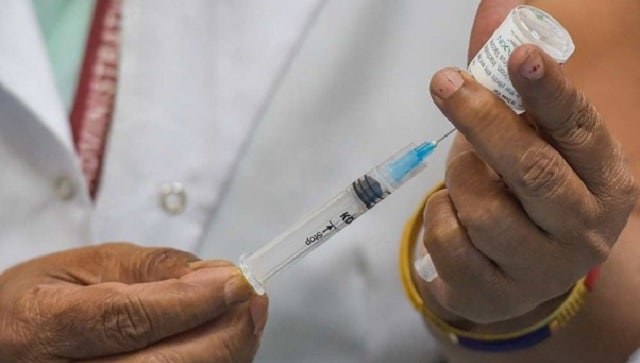The vaccination process for people aged 18 to 45 years shows how the use of technology, backed by the wrong policy and implementation design can lead to large-scale exclusion

Representational image. PTI
The second wave of the coronavirus pandemic in India has been brutal, affecting both lives and livelihoods. Governments, both at the Centre and the state have been caught unprepared. Partially as a response to the increasing number of positive cases and deaths, the government has started vaccinating people between the ages of 18 and 45 years, in addition to earlier phases covering those above 45, as well as health and frontline workers.
pandemic in India has been brutal, affecting both lives and livelihoods. Governments, both at the Centre and the state have been caught unprepared. Partially as a response to the increasing number of positive cases and deaths, the government has started vaccinating people between the ages of 18 and 45 years, in addition to earlier phases covering those above 45, as well as health and frontline workers.
For Phase 2, it was initially announced that online registration was mandatory, but this was relaxed later, and the options of walk-in registration and facilitated cohort registration for those who are unable to access internet were announced. While this meant that each vaccine shot took longer since the beneficiary still had to be registered, this at least ensured that the degree of exclusion was alleviated. This is not true of Phase 4. It has been made very clear that online registration is mandatory and there have been no provisions made for walk-ins or the cohort approach discussed above. This is extremely exclusionary. There are multiple exclusion points that exist in making online registration mandatory for vaccination. Let us understand these.
As per TRAI telecom data from 21 January, India has a tele density of 87 percent, but a little more than half of India’s population has access to broadband internet. Further, the report shows that rural tele density is only 59.5 percent. Such states as Bihar, Uttar Pradesh, and Madhya Pradesh that score low on economic indicators also have the lowest overall tele density. The ‘Digital in India’ report by IAMAI has shown that in terms of internet use, points of exclusion exist on factors of age, gender, location, education etc.
Additional exclusion points may exist based on religion, caste, and disability. The report also shows that 99 percent of internet users in India use smartphones to access the internet. It is important to note that India is considered as one of the least affordable countries in terms of smartphone prices, as per this report. These points pertain to access and infrastructure, but even if those can be circumvented, there is an additional exclusion point based on the ability to use the internet. As per the NSS 75th Round report on Household Social Consumption on Education in India, only around 20 percent of Indians have the ability to use the internet, with disparities existing on the basis, of age, location, and gender.
Next, let us talk about language. For now, the CoWIN portal seems to be available only in English. As per Census 2011 data, only around 10 percent of Indians can speak some English. Further, a Google report from 2020 shows that 90 percent of Indian internet users prefer local language content. This becomes difficult to explain, especially when the state has shown the capacity to accommodate this with the multi-lingual Aarogya Setu app.
Finally, if the points of exclusion discussed above were not enough, it has been reported that programmers have built bots which can automatically book slots on the CoWIN portal.
The vaccination process for 18- to 45-year-old beneficiaries is an example of how the use of technology, backed by the wrong policy and implementation design can lead to large-scale exclusion. The fact that the health minister chooses to celebrate the number of OTPs sent out as a sort of validation of the use of technology shows that the state has not really understood how to evaluate the impact of technology. This view evaluates the functioning of technology, not whether the use of technology is achieving the intended purpose. Perhaps that is why the State was in denial over the CoWIN portal crashing as soon as registrations for Phase 4 were opened.
We seem to be an outlier in this approach. In the United States, there are online and offline options available to find out about vaccine centres near you. Most vaccine providers are taking appointments online, but offline options also exist. It is important to note that the US has launched a $3.2-billion Emergency Broadband Benefit to ensure internet access during the pandemic for those who cannot afford it. We had made a similar suggestion for India in the Vidhi Briefing Book 2020. In the UK, the vaccine is being offered to certain priority groups. The direction is to register online for appointments, but for those who cannot do it, there is a helpline number given where people can call to get bookings. Even Singapore, the country with one of the highest broadband penetration rates and fastest internet speeds, has an option for offline registration.
This unnecessary and oblivious use of technology is even more surprising considering India has had a history of successful immunization programmes, without any major use of technology. Some might argue that with limited vaccines, and rising cases the government has chosen this option to accelerate vaccination. However, vaccination rates have actually been falling in Phase 4. Making online registrations mandatory may also help in crowd management, but surely exclusion cannot be a criterion for that.
This exclusion is something which is addressed on the CoWIN platform itself. FAQ A6 reads “How can citizens with no access to smart phones or computers manage online registration?” The answer is illuminating; “Up to four people can be registered for vaccination using the same mobile number. Citizens can take help from friends or family for online registration”.
Essentially, this means that the State is okay with the exclusion and those who do not have access are dependent on the kindness of others. The State is absent and not responsible for the crores of Indians who cannot get access to vaccines due its own lack of planning. The State has further chosen to exacerbate this with the addition of a faulty vaccine distribution policy.
The author is senior resident fellow at the Vidhi Centre for Legal Policy and development lead at Nyaaya










